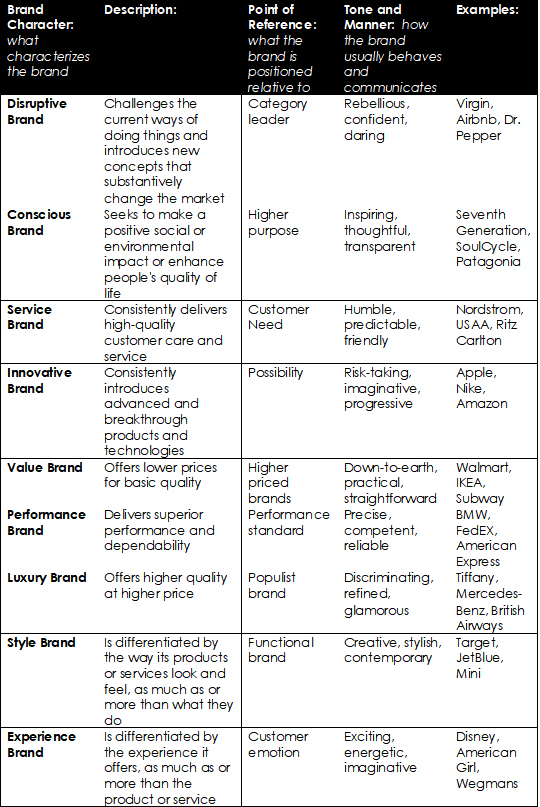9 Different Types of Brands
Here’s a hypothesis: There are essentially nine different types of brands and you can jumpstart the development of your brand strategy by identifying the one that’s right for you.
I’ve developed this hypothesis after working on brands for over 25 years. I’ve come to realize that there is a finite number of brand types or ways that brands compete and are positioned, and after quite a bit of research and analysis, I’ve been able to identify nine. (I also got a lot of input from my community when I asked them for feedback earlier this year — thank you if you were one of the super smart people who helped me!)
These nine brand types differ from brand archetypes, which classify brands according to storytelling character types like the Hero, the Joker, and the Innocent. I have relied on brand archetypes in past brand strategy development work — and will continue to do so — but at times, I’ve found the typology too abstract for some of my clients to grasp or too oriented to communicating the brand vs. operationalizing it.
In my research, I also came across some helpful sources on other ways to classify brands, including this piece by Mark di Somma that lists 21 different types of brands based on the role they play (e.g., corporate vs. product brand, ingredient brand, and employer brand.)
But I want to focus on the different strategies or stances that brands take to shape their identity and positioning. I want to help you identify the general type of brand you want to build, so that you can more clearly and easily pinpoint the specific brand identity and positioning you aspire to.
I also want to reinforce the need for a single, focused, different brand idea. Too many people develop brand strategies, and therefore brands, that are generic, vague, or ambiguous. By selecting one type for your brand, you’re more likely to end up with a powerful brand strategy.
So here are the nine types, labeled by what characterizes or differentiates them the most:
- Disruptive Brand — Challenges the current ways of doing things and introduces new concepts that substantively change the market
- Conscious Brand — Is on a mission to make a positive social or environmental impact or enhance people’s quality of life
- Service Brand — Consistently delivers high-quality customer care and service
- Innovative Brand — Consistently introduces advanced and breakthrough products and technologies
- Value Brand — Offers lower prices for basic quality
- Performance Brand — Offers products that deliver superior performance and dependability
- Luxury Brand — Offers higher quality at higher price
- Style Brand — Is differentiated through the way its products or services look and feel, as much as or more than what they do
- Experience Brand — Is differentiated through the experience it provides, as much as or more than the product or service
Please note these important points about the nine different types of brands and this approach to classifying brands:
- Some characteristics are — or should be — embraced by all brands. All brands should offer good service, for example — but a brand that falls into the Service brand type makes it the top priority to consistently deliver high-quality customer care and service. Its strategies, operations, and ultimately customer value propositions are all centered around service first.
- Although two or three brand types might seem relevant to your brand — and there’s certainly overlap between them — you should identify a primary one. Your primary brand type should be the one that aligns best with your overarching purpose, resonates most with your organization, and gives you the most impact with your customers.
- Across the life of your brand, it might evolve from one type to another as customers, competitors, and culture changes. But if you’re just starting out, I recommend selecting the one that seems most evergreen or sustainable.
- For many brands, there is a difference between how you’re currently perceived and how you want to be. It’s possible to change your brand type, but make sure your aspirations are realistic — e.g., a value brand is unlikely to become a luxury one or a style one.
- Each brand type offers a wide range of options for establishing a unique brand identity and a precise brand positioning for your brand. Consider the differences in purpose, scope, target customer, and personality between three different performance brands: BMW, FedEX, and American Express.
The following chart provides more information about each of the nine brand types:
I hope this post has been helpful — and I’m eager to hear your feedback. Comments are open!
related:



